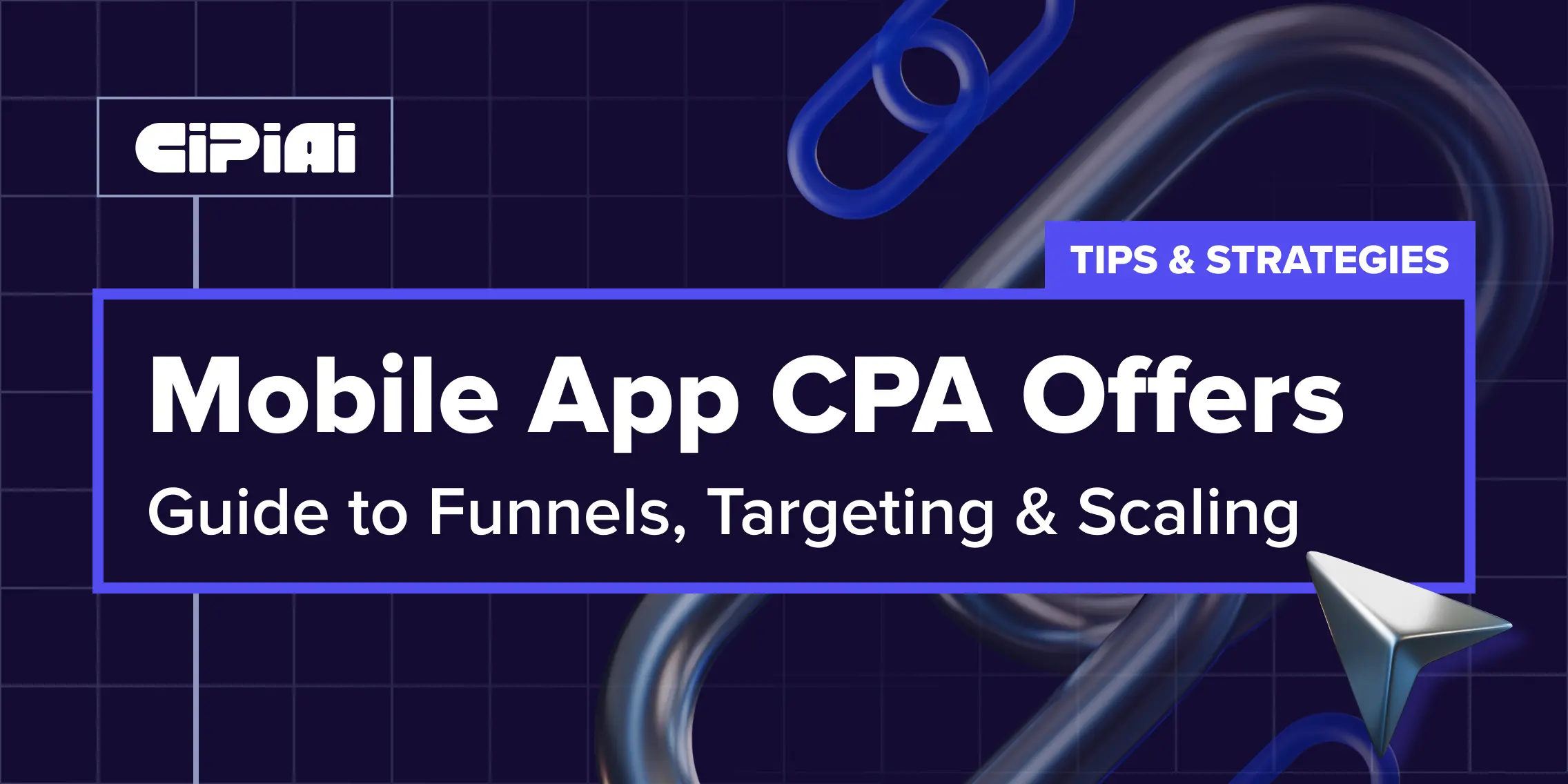
How to Promote Utility CPA Offers in 2025
Explore the best utility CPA offers in 2025 — including VPNs, adblockers, cleaners, and APKs. Learn what traffic sources convert and how to launch safely.

Picture a potential user waiting for public transport—idly scrolling on their phone—then seeing your install ad and tapping it. That split-second action is the magic of mobile affiliate marketing in 2025. In fact, 62% of affiliate-driven visits come from mobile devices, confirming that affiliates must prioritize mobile-first strategies. Meanwhile, global affiliate revenue is set to reach $17 billion this year, fueled by mobile dominance.
Why should you run CPA mobile campaigns right now?
Consider this: mobile ad spend is projected to hit over $400 billion this year, cementing mobile as the fulcrum of performance traffic.
🔗 Want to see mobile offers that perform? Check out CIPIAI’s [Utility Affiliate Programs 2025] to explore verified, high-converting CPI/CPA campaigns across devices and regions.

Before you optimize campaigns, let’s define essential terms. These concepts differentiate CPI offers from deeper CPA models—and knowing the difference affects your funnel, risk, and profitability:
As explained in the RichAds guide on CPC vs CPI vs CPA, CPI is ideal for volume and quick testing, while CPA aligns better with profit-driven affiliates.
To run mobile CPI offers, it’s critical to set up postback URLs—server-to-server callbacks that tell your tracker when an app install or action completes. This enables real-time funnel optimization and boosts ROI.
A well-designed pre-lander warms up cold traffic before redirecting to the app store. It might display an “app scan,” highlight key features, or preview benefits—significantly increasing conversion rates.
Adsterra’s CPA campaign guide describes them as essential for reducing bounce rates and enhancing campaign legitimacy.
Targeting isn’t just a parameter decision—it’s a strategic driver for your campaign’s success. When you run CPA mobile campaigns, aligning your offer with the right GEO tier and device can profoundly impact performance.
Understanding GEO tiers is critical:
As detailed in Mapendo’s guide, GEO selection deeply influences conversion performance and long-term user retention.
Not all devices are created equal:
This is vital when selecting best mobile CPA offers—your platform choice informs funnel design, bid strategies, and creative format.
To explore high-converting, geo-optimized offers tailored for mobile, check CIPIAI’s curated list of Utility CPA Offers 2025.
There’s a reason why mobile CPA offers that convert always follow a specific structure. Success in 2025 doesn’t come from luck—it comes from smart funnel logic and strict platform compliance.
Here’s a proven structure that maximizes conversions for mobile CPA:
Each stage is optimized not just for CTR and CR, but also for App Store Policy Compliance. A high CTR won’t matter if your app gets removed for misleading claims or aggressive CTAs.
You’re not just converting users—you’re also protecting your traffic source and advertiser relationship.
📘 For accurate tracking through all funnel steps, check out our guide on Affiliate Tracking Software to make sure your postback setup reflects user events properly.
Targeting and funnels lay the foundation, but it’s your creatives that determine whether audiences click, install, and ultimately convert. In mobile affiliate marketing, delivering the best mobile CPA offers hinges on compelling ad formats and systematic testing.
According to PropellerAds’ guide on Push Notification Strategy to Boost Conversions, ongoing creative optimization can yield a 25% lift in CTR, directly translating into more installs and higher revenue.
Run at least 3–5 creatives simultaneously, evaluate performance by GEO and device, and scale the top 20% while pausing the rest. This disciplined “test-and-scale” loop is key to maintaining ROI growth on best mobile CPA offers.
Optimizing mobile CPA campaigns requires a balance between data clarity and real-time reaction. Whether you’re testing creatives or filtering traffic, a good postback setup is your radar.
Start by configuring server-to-server (S2S) postbacks — they allow precise tracking of conversions, traffic sources, and payout performance. Adsterra provides a straightforward tutorial on how to set up a postback URL, including macros for subIDs, GEOs, and device types.
Once tracking is live, focus on three metrics:
According to Backlinko’s CPA Marketing Guide, the fastest way to scale is by testing one variable at a time — headline, image, CTA — and running clean rotations. Introduce A/B testing tools, like Voluum or Binom, to compare flows and adjust per segment (e.g. Android vs iOS).
Fraud is another critical risk. Filter out junk traffic with tools like fraud-score.com or the anti-fraud layer built into advanced trackers. Look for:
If you’re using affiliate tracking software, ensure it includes anomaly detection, bot filtering, and log-level exports.
Even seasoned affiliates stumble with mobile funnels, especially when pushing CPI offers affiliate in fast-paced environments. Here are the common CPA mistakes that can derail your campaign:
Driving traffic directly to the app store overlooks warming and filtering steps, reducing CR and increasing risk. RichAds highlights in its pre-landing page guide how pre‑landers boost conversions by building trust and engagement.
Using high-pressure messages (“Your phone is infected!”) without pre-qualification or flow adaptation triggers moderation. Avoid panic tones unless supported by niche compliance; clean, value-driven visuals often perform better.
A typical CPI offers affiliate error is mismatched tracking links between Android and iOS. Always segment flows per platform and ensure links adapt based on device_id or user_agent to avoid broken redirects.
Advertisers today track installs, session length, uninstall rate, and in-app actions. Ignoring these metrics means missing penalties or optimization opportunities. Postbacks and event tracking are non-negotiable.
Avoiding these pitfalls requires a discipline-first mindset: use smart pre‑landers, thoughtful creatives, accurate link infrastructure, and comprehensive tracking to stay clean and profitable.
You’ve found a CPA campaign that converts — now what?
To scale CPA campaigns effectively in 2025, you need to combine cautious experimentation with systemized expansion. The goal isn’t to just throw more money at your top ad — it’s to find patterns that replicate profitably across audiences and geos.
Initial test budgets for the best mobile CPA offers typically range from $20 to $50. This lets you gather statistically significant data on key parameters (CTR, CR, ROI) without overcommitting.
If you validated Tier-3 Android traffic, move next to Tier-2, then cautiously test iOS. Use geo-specific creatives — a one-size-fits-all banner won’t work equally well in Vietnam and Mexico.
Keep your top-performing combinations in a separate “gold” campaign. All others should remain in test groups. Use whitelists for placements or zones with strong ROI.
Even winning creatives fatigue. Rotate ad formats weekly: switch between static banners, short-form video, swipe galleries. Use A/B tools to test CTA placement, image style, or headline framing.
Increase your bids gradually — 10–15% daily — while watching for drop-offs in CR. Consider time-of-day targeting: install spikes often occur evenings and weekends.
Scaling success hinges on structured experimentation — not emotional attachment to a single funnel. Monitor KPIs tightly, update offers regularly, and don’t hesitate to pause and re-test if profitability dips.
Looking for direct CPI & CPA offers with clean tracking and fast payouts? Start with CIPIAI — a trusted partner for mobile affiliates.

We’ve curated exclusive utility and cleaner app offers with real-time analytics, manual approvals, and weekly payments. No guesswork — just tested funnels and stable EPCs.
👉 Explore our top converting flows in:
CPI (Cost Per Install) pays you when a user installs an app. CPA (Cost Per Action) usually includes additional steps — like sign-up, trial, or specific in-app behavior. CPI offers are faster to convert, while CPA often brings higher payouts.
Yes — cleaner and booster apps remain high-volume winners thanks to their broad appeal, low friction, and recurring use cases. Read more in our Utility CPA Offers 2025.
In many cases, yes. Even basic pre-landers help qualify users, increase CR, and avoid policy violations — especially on paid traffic. They’re also useful for cloaking, warm-ups, or adding timers/benefits.
Use a mobile-friendly affiliate tracker that supports macros, postback integrations, and device-level reporting. Full comparison here: Affiliate Tracking Software.
Tier-2 and Tier-3 countries tend to offer the best CPI volume-to-cost ratio, especially with push or pop traffic. Split-test early to find sweet spots.
Avoid misleading creatives, double-check store policies, and never skip the pre-lander. Always use tracker redirects and rotate creatives to reduce flagging.
Yes, but results will be slower. Consider SEO, social media traffic (e.g., Reddit, Telegram), or content hubs. Paid traffic (Push, In-app) remains the fastest scaling option.
Copyright © 2025. Bisdev Solutions Limited
All rights reserved